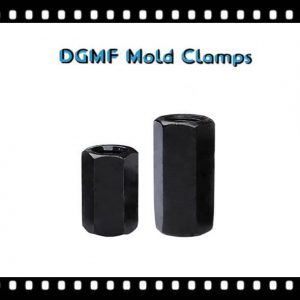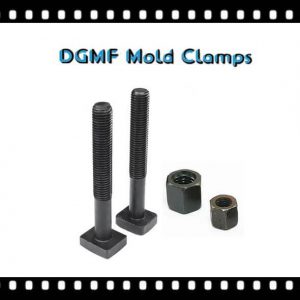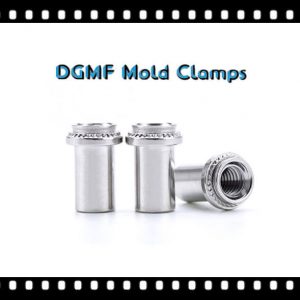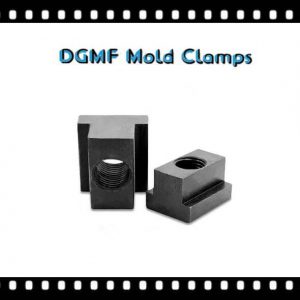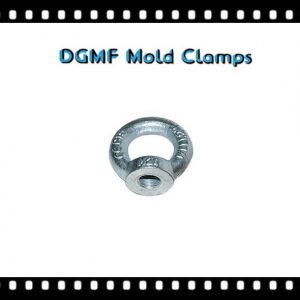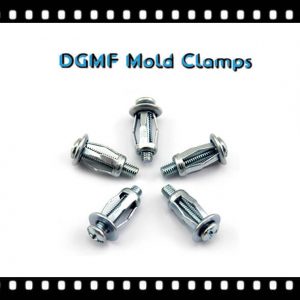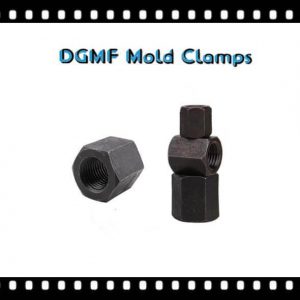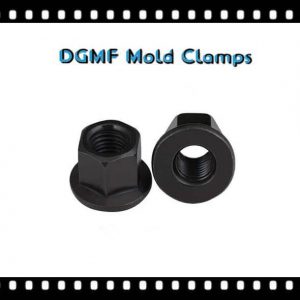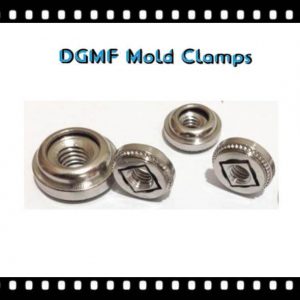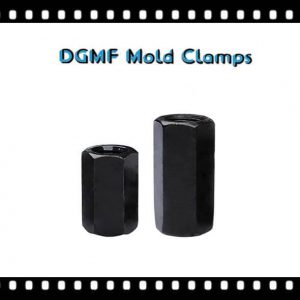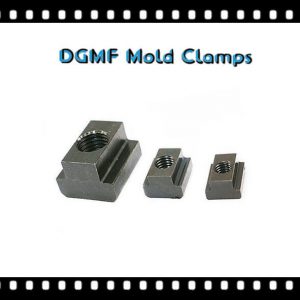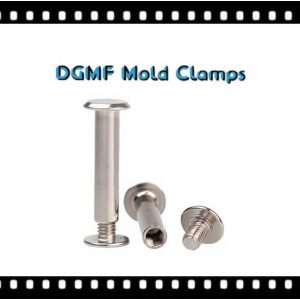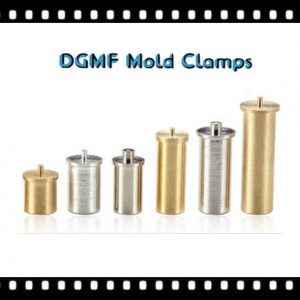Nuts
-
Threaded Rod Extension Nuts
Read more -
T Bolts And Nuts
Read more -
Self-clinching Blind Fasteners Blind Press Nuts
Read more -
Milling Machine T-Slot Nuts
Read more -
Lifting Eye Nuts DIN 582
Read more -
Jack Nuts Petal Nuts Threaded Insert Screw Anchors
Read more -
Heavy Hex Nuts
Read more -
Forged Flange Nuts
Read more -
Floating Nut
Read more -
Extra Long Coupling Nuts
Read more -
DIN 508 T Nuts For Milling Machine
Read more -
Chicago Binding Screws Sex Bolt
Read more -
CD Weld Standoffs
Read more
Hardware Nuts Supplier
DGMF Mold Clamps Co., Ltd is the hardware nuts supplier and mould clamps manufacturer in China.
What is Nut (component)?
A nut is a part that is screwed together with a bolt or screw for fastening. A component that must be used in all manufacturing machinery is divided into carbon steel, stainless steel, non-ferrous metals (such as copper), and other major types according to different materials.
species
Nuts are parts that tightly connect mechanical equipment. Nuts and bolts of the same specification can be connected together through the inner thread.
For example, M4-P0.7 nuts can only be connected with M4-P0.7 series bolts (in nuts, M4 means that the inner diameter of the nut is about 4mm, and 0.7 means that the distance between the two threads is 0.7mm);
The same is true for American products. For example, 1/4-20 nuts can only be matched with 1/4-20 screws (1/4 means that the inner diameter of the nut is about 0.25 inches, and 20 means that there are 20 teeth in each inch).
Nut Material
Stainless steel
Self-locking nut, lock nut, lock nut, four-claw nut, screw-in nut, safety nut, thin rod screw connection nut, self-locking hexagonal cap nut, special anchor nut, hexagonal crown thin nut, ring nut.
Fine pitch all-metal hexagonal flange lock nut, all-metal hexagonal flange lock nut, fine pitch non-metallic insert hexagonal flange lock nut, fine pitch hexagonal flange nut, Welded square nuts, welded hexagonal nuts, fastened nuts, embedded round nuts,
Slotted round nuts, round nuts with holes on the side, round nuts with holes on the end, small round nuts, Round nuts, ring nuts, wing nuts
Copper
Copper nuts, inlaid copper nuts, knurled copper nuts, embedded copper nuts, injection-molded copper nuts, etc.
Alloy
Zinc-copper alloy nuts, etc.
Nut Standard basis
According to the attributes of nuts, there are mainly national standards (GB), German standards (DIN), international standards (ISO), Japanese standards (JIS), American standards (ASTM/ANSI), and other standards.
Among them, the national standard, the German standard, and the Japanese standard are represented by M (for example, M8, M16), while the American system and the British system are represented by fractions or # (such as 8#, 10#, 1/4, 3/8).
Commonly used national standards for nuts
GB41 Ⅰ Hexagon Nut-Grade C
GB6170 Type Ⅰ Hexagon Nut-Grade A, B
GB6171 Ⅰ Hexagon Nut—Fine Pitch—Class A and B
GB6172 Hexagon Thin Nut-Class A, B-Chamfer
GB6173 Hexagon Thin Nut-Fine Thread-Grade A, B
GB6174 Hexagon Thin Nut-Grade B-No Chamfer
GB6175Ⅱ Hexagon Nut-Grade A, B
GB6176Ⅱ Hexagon Nut-Fine Thread-Class A, B
GB6177 Hexagon Flange Nut—Grade A
GB55 Hexagon Thick Nut
GB56 Hexagon Super Thick Nut
GB1229 large hexagon nut (high strength for steel structure)
Principle of Locknut
The locknut is composed of two parts, each part has a staggered cam. Because the internal wedge design slope angle is greater than the bolt nut angle, this combination is tightly bitten into a whole, when vibration occurs, it prevents The protruding parts of the loose nut are staggered to generate lifting tension, so as to achieve a perfect anti-loose effect.
Locknut Main features
Easy to install
Integrity
No washer required
Easy to disassemble
Reusable made of medium carbon steel
Can be used with 8.8, 10.9, and other high-strength bolts
Passed the US military—MIL-STD 1312 Vibration Test7. Results passed the Junker Test
Detected by Dynamic Test
Scope of locknut applications
Cars, trucks, buses, compressors, construction machinery, wind power equipment, agricultural machinery, foundry industry, drilling equipment, shipbuilding industry, mining equipment, oil drilling rigs (onshore or offshore), utilities, rail transit, transmission systems, Metallurgical equipment, electronic products, etc.
Fasten the screw nut
Purpose
To lock the outer joint of the harness or other pipe fittings.
The working principle of the nut is self-locking by the friction between the nut and the bolt. However, the reliability of this self-locking will be reduced in dynamic loads.
On some important occasions, we will take some anti-loosening measures to ensure the reliability of the nut locking. One of the anti-loose measures is to use a lock nut.
There are also three types of lock nuts.
The first is to use two identical nuts to screw on the same bolt and add a tightening torque between the two nuts to make the bolt connection reliable.
The second is a special lock nut, which needs to be used together with a lock washer. The special lock nut is not a hexagonal nut, but a middle-round nut.
There are 3, 4, 6, or 8 gaps on the circumference of the nut (depending on the size of the nut and the product series of the manufacturer). Several notches are not only the focus of the tightening tool but also the entry point of the locking washer.
The third type is to drill through threaded holes from the outer surface of the nut to the inner thread surface (usually two, distributed at 90 on the outer surface), used to screw in small diameter countersunk screws, the purpose is to thread Apply a centripetal force to prevent the lock nut from loosening.
A lock nut with better quality sold on the market is inlaid with a small piece of copper that is consistent with the thread of the lock nut on the inner surface of the nut to prevent the radial jack screw from directly contacting the locked thread and damaging the latter.
This kind of lock nut has gradually begun to be applied in the occasion of the shaft end locking of rotating parts, such as the anti-loosening of the bearing of the ball screw mounting end.
The second anti-loose method is more reliable than the first, but the structure is relatively complicated. Compared with the first two, the third clock has the characteristics of a better anti-loose effect, simpler and more beautiful structure, and smaller axial size.
Nut material
Carbon steel, stainless steel, copper, alloy, etc.
Other nuts
Embedded nut
Copper nuts made of various embossed wires (usually lead brass, such as H59, 3604, 3602). The embedded knurled brass nuts we come into contact with are all processed by precision automatic lathes. The reference standard for embedded knurled copper nuts comes from the national standard GB/T809.
The main operation method of the embedded knurled copper nut is injection molding. After heating, it is embedded in the plastic part or direct injection molding. If mold injection is used, the melting point of PA/NYLOY/PET is above 200°C, and the embedded nut is hot melted After the plastic parts are inserted, the temperature rises rapidly.
After injection molding, the plastic body rapidly cools and crystallizes, and becomes hard. If the temperature of the embedded nut is still at a high temperature, it may be poured to the place where the copper nut and the plastic part are in contact and begin to lose or crack.
Therefore, copper nuts instead of carbon steel nuts are used in the injection molding of embedded nuts.
There are two ways to form the outer grain knurling of the embedded copper nut. One is to use the copper raw material to draw the pattern and then produce on the upper equipment.
Generally, the drawing pattern in this way is straight, and the other is to use The round copper material is directly embossed while tapping the teeth during the production process.
This processing method can produce some non-standard size knurled copper nuts. The embossed shape of the embedded copper nut can be selected by the user, such as mesh, Various rolling patterns such as eight-character embossing, and herringbone embossing.
Alias and usage
Copper nuts, also known as embedded nuts and embedded copper nuts or plastic embedded nuts, are divided into hot-melt copper nuts, hot-pressed copper nuts, embedded copper nuts, and ultrasonic copper nuts according to different methods of use.
This product is widely used in the embedded parts of mobile phone shells/pen book shells/injected parts/plastic parts. It is used as an internal thread. Generally, the outer circle is embossed to prevent sliding.
Stainless steel nut
Hex nuts (GB6170/DIN934), thin nuts (GB6172/DIN439), heavy-duty nuts, nylon lock nuts (DIN985-DIN982 thick type), all-metal locknuts (DIN980M), acorn nuts (DIN1587) ), flange nuts (GB6177/DIN6923), flange nut nylon lock nuts (DIN6926), square nuts (DIN928), hexagon weld nuts (DIN929), wing nuts (GB62, DIN315, American), K-Lock Nuts / Keps Nuts, etc.
Specification: M1.6-M64
Alloy steel nuts
Hexagon nuts (GB6170/DIN934, GB6175), flange nuts (GB6177/DIN6923)
Round nuts (GB812), small round nuts (GB810), American square nuts, American hexagonal nuts (ANSI/ASME B18.2.2), heavy-duty nuts (metric, American).
Specification: 5/16-4″.
Nut specifications
The nut specification table is to unify all kinds of nuts in detail and use the table to subdivide some of the nut specifications. There are many types of nuts and nuts of different materials. Each type of nut has different specifications, and each type of screw also has its mechanical properties and functions.
The national standard for various nuts
· Square nut C grade GB 39-88
· Hexagon nut C grade GB /T41-2000
· Hexagon Thick Nut GB 56-88
· Wing nut GB 62-88
· Ring nut GB 63-88
· Combined cap nut GB 802-88
· Spherical hexagon nut GB 804-88
· Fastening nut GB 805-88
· Knurled high nut GB 806-88
· Knurled thin nuts GB 807-88
· Small hexagon nuts with fine pitch GB 808-88
· Embedded round nut GB 809-88
· Small round nut GB 810-88
· Round nut GB 812-88
· GB 815-88 round nut with a hole on the end
· GB 816-88 round nuts with holes on the side
· Slotted round nut GB 817-88
· Type 1 hexagon lock nuts with non-metallic insert GB /T 889.1-2000
· Type 1 non-metallic insert hexagon lock nuts with fine pitch GB /T 889.2-
2000
· Cap Nut GB 923-88
· 1 type hexagon nut GB /T 6170-2000
· Type 1 hexagon nut with fine pitch GB /T 6171-2000
· Hexagon thin nuts GB /T 6172.1-2000
· Non-metallic insert hexagonal lock thin nuts GB /T 6072.2-2000
· Hexagon thin nuts with fine pitch GB /T 6173-2000
· Hexagon thin nuts without chamfer GB /T 6174-2000
· Type 2 hexagon nuts GB /T 6175-2000
· Type 2 hexagon nuts with fine pitch GB /T 6176-2000
· Hexagon flange nuts GB /T 6177.1-2000
· Hexagon flange nuts with fine pitch GB /T 6177.2-2000
· Type 1 Hexagon Slotted Nuts-Grade A and B GB 6178-86
· Type 1 Hexagon Slotted Nut-Grade C GB 6179-86
· Type 2 Hexagon Slotted Nuts-Grade A and B GB 6180-86
· Hexagon Slotted Thin Nuts-Grade A and B GB 6181-86
· Type 2 hexagon lock nuts with non-metallic insert GB /T 6182-2000
· GB/T 6183.1-2000 Hexagon flange lock nuts with non-metallic inserts
· Non-metallic insert hexagonal flange face lock nuts with fine pitch GB /T
6183.2-2000
· Type 1 All-Metal Hexagon Lock Nut GB /T 6184-2000
· Type 2 All-Metal Hexagon Lock Nuts GB /T 6185.1-2000
· Type 2 all-metal hexagonal lock nuts with fine pitch GB/T 6185.2-2000
· Type 2 All-Metal Hexagon Lock Nut Grade 9 GB /T 6186-2000
· All metal hexagonal flange lock nuts GB /T 6187.1-2000
· All metal hexagonal flange face lock nuts with fine pitch GB/T 6187.2-2000
· Type 1 hexagon slotted nut with fine pitch A and B grade GB 9457-88
· Type 2 hexagon slotted nut with fine pitch A and B grade GB 9458-88
· Hexagon slotted thin nuts with fine pitch A and B grades GB 9459-88
· Welded square nuts GB /T 13680-92
· Welded hexagon nuts GB /T 13681-92
· Flat head rivet nuts GB /T 17880.1-1999
· Countersunk rivet nuts GB /T 17880.2-1999
· Small countersunk head rivet nuts GB /T 17880.3-1999
· 120° small countersunk head rivet nuts GB /T 17880.4-1999
· Flat head hexagon rivet nuts GB /T 17880.5-1999
· Hexagon nuts for precision machinery GB /T 18195-2000
DGMF Mold Clamps Co., Ltd manufactures the mold clamps, and supplies the injection mold components, such as Clamps, Toggle Clamps, C Clamps, Pins, Bushings, Positioning Components, Lock Mold Components, Reset Extrusion, Cavity, and Core Components, Coolings, Die Press Components, Punch And Die, Guide Components, Self-lubricating Components, Springs, Machine Tools, Gate Valves, Machine Mounts, Vises, Fasteners, Lifting, Bolts, Nuts, Washers, etc.
Contact the DGMF Mold Clamps teams for more details about the fastener nuts such as fastener nuts specifications, fastener nuts pricing, fastener nuts inventory, etc.
Showing all 13 results
-
CD Weld Standoffs
Read more -
Chicago Binding Screws Sex Bolt
Read more -
DIN 508 T Nuts For Milling Machine
Read more -
Extra Long Coupling Nuts
Read more -
Floating Nut
Read more -
Forged Flange Nuts
Read more -
Heavy Hex Nuts
Read more -
Jack Nuts Petal Nuts Threaded Insert Screw Anchors
Read more -
Lifting Eye Nuts DIN 582
Read more -
Milling Machine T-Slot Nuts
Read more -
Self-clinching Blind Fasteners Blind Press Nuts
Read more -
T Bolts And Nuts
Read more -
Threaded Rod Extension Nuts
Read more

